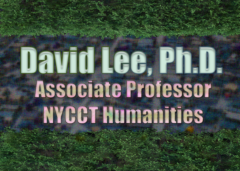Statement of Teaching
I’ve taught undergraduates for fifteen years, starting as a teaching assistant for large lecture classes such as Introduction to Communication, Communication and Diversity, Interview Communication and Introduction to American Studies. Before City Tech I taught Introduction to Media Studies, Mass Media Effects, Health Communication, Interpersonal Communication, and, of course, Public Speaking. In the process of teaching I have developed a set of three interconnected approaches to teaching which gets students excited and participating on a level playing field. These three approaches are: Interactive learning, multimedia and diversity.
Interactive Learning
Communication is not only a product; it is also an active process, and students learn about communication by doing it. Inviting students to the classroom as interactive participants in a learning conversation (instead of passive receivers of knowledge) helps me get them interested and develop their critical thinking and communication skills. Concepts of learning which rely on a “transmission” model of communication are based on the idea that knowledge resides in the mind of the instructor and flows into the ears of the passive listeners. This model may be suitable for the memorization of facts, but for a communication course it overemphasizes product over process. What sets communication apart as an academic field is how we can build participation and dialogue into features of a course. Instead of being spoon fed the answers, students have the opportunity to make discoveries and connections during interactive lectures. As a facilitator I use the Socratic method, asking searching or naïve questions that allow students to be rewarded by coming up with answers themselves during an interactive process. Discussion questions in a safe, collaborative forum allow students to articulate opinions and experiment with crafting arguments supported by evidence. An interactive learning approach involves welcoming the first-person voice and crowd-sourcing examples to illustrate theoretical concepts. Presentations place each student at the head of the class to explain their research and explain their most interesting findings, answering questions from their classmates and the instructor. Effective communication isn’t ‘one size fits all’ so I work with students individually and in groups to help them identify their own styles of communication and collaborate with them on strategies for improvement. Interactive classrooms also entail digital interfaces with all technical affordances students are used to online.
Multimedia
While Web 1.0 was ‘read only,’ incoming freshman today have already spent their lives participating in virtual communities and they are fluent in interactive technologies. Today’s students want interactive (rather than passive) communication technologies where they can comment, tag, like, down vote, gain followers, and dialogue with others worldwide. In my experience they prefer to have interactive experiences with course material where they can use technologies to contribute to a co-generated curriculum. To address this, I set up features on Blackboard where students post links to news stories, videos or apps, and tag and comment on each other’s posts. User generated content such as wikis and folksonomies get students directly involved in providing definitions for key terms and communication theories, using their own media experiences as an evidential basis. Lectures are accompanied by rich audio-visual slideshows with images, memes, animations, web links and embedded video clips. Multimedia is the grammar of this generation, and because of my skills in Photoshop, Adobe Premiere and Web Streaming I can design custom multimedia for my courses which invite participation from students. I have good responses from students who appreciate the use of communication technologies that rope them in as co-contributors to the educational process rather than just passive receivers.
Diversity
The most central part of my teaching philosophy that I will to emphasize is diversity. The term is usually a descriptor of the student body, rather than a teaching approach, but the broader definition is “variety.” Signifying classrooms with students from a variety of racial, ethnic, geographic and cultural backgrounds, diversity also refers to using a variety of pedagogical approaches. Informed by ideas of universal design, as we cherish diversity in the classroom I offer diverse ways to excel in my course for a variety of learning and communication styles. I avoid a ‘cookie cutter’ approach where students are required to speak and gesture according to an ethnocentric ideal. Often students are engaged in cultural practices, content production, activist causes or fan communities and their diverse experiences are welcomed. Media studies curricula sometimes need to be adapted to highlight media practices outside of the U.S. and from marginalized voices. Media textbooks may exclude media from important social movements like civil rights, women’s liberation, gay liberation and national independence movements. In my multicultural classrooms students are introduced to a diverse set of interpretive tools for understanding global media, including concepts like convergence, acculturation, mainstreaming, hegemony and the subaltern. This approach to diversity goes beyond platitudes of tolerance to a more cosmopolitan understanding of global media. In addition to appreciating cultural diversity, there are many styles of communication and learning, some more oral, some more written, some more verbal, some more pictorial. In addition to quizzes, surveys, readings, impromptu speeches, discussion forums, small groups, one-on-one meetings, and formal presentations, students contribute to online discussions. With diversity, so diversity. A diversity of approaches is designed to meet the learning needs of diverse classrooms. I have been fortunate to teach culturally diverse classrooms and in my experience there are some students who enter the classroom at a disadvantage because of English as a second language or due to inequalities in education for underserved communities. While I connect these students to resources such as the ESL and Academic Writing Centers, I also work with them individually. Inspired by Vygotskian ideas about proximal learning, I sit one on one with students in front of the computer screen and demonstrate my process of researching, reading and outlining. The most gratifying experience of teaching is to help students previously under-represented in higher education gain confidence in their abilities and acquire knowledge and skills which empower them.




